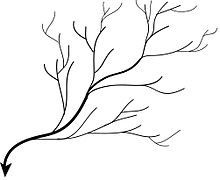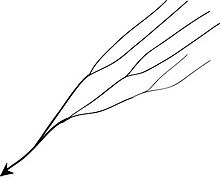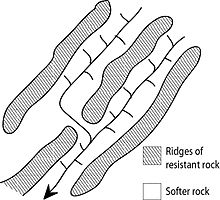- Drainage system (geomorphology)
-
In geomorphology, a drainage system is the pattern formed by the streams, rivers, and lakes in a particular drainage basin. They are governed by the topography of the land, whether a particular region is dominated by hard or soft rocks, and the gradient of the land. Geomorphologists and hydrologists often view streams as being part of drainage basins. A drainage basin is the topographic region from which a stream receives runoff, throughflow, and groundwater flow. Drainage basins are divided from each other by topographic barriers called a watershed. A watershed represents all of the stream tributaries that flow to some location along the stream channel. The number, size, and shape of the drainage basins found in an area varies and the larger the topographic map, the more information on the drainage basin is available.[1]
Contents
Types of drainage system
Drainage systems can fall into one of several categories, depending on the topography and geology of the land:
Dendritic drainage system
Dendritic drainage systems (from Greek δενδρίτης, dendrites, "of or pertaining to a tree") are the most common form of drainage system. In a dendritic system, there are many contributing streams (analogous to the twigs of a tree), which are then joined together into the tributaries of the main river (the branches and the trunk of the tree, respectively). They develop where the river channel follows the slope of the terrain. Dendritic systems form in V-shaped valleys; as a result, the rock types must be impervious and non-porous.[2]
Parallel drainage system
A parallel drainage system is a pattern of rivers caused by steep slopes with some relief. Because of the steep slopes, the streams are swift and straight, with very few tributaries, and all flow in the same direction. This system forms on uniformly sloping surfaces, for example, rivers flowing southeast from the Aberdare Mountains in Kenya.
Trellis drainage system
The geometry of a trellis drainage system is similar to that of a common garden trellis used to grow vines. As the river flows along a strike valley, smaller tributaries feed into it from the steep slopes on the sides of mountains. These tributaries enter the main river at approximately 90 degree angles, causing a trellis-like appearance of the drainage system. Trellis drainage is characteristic of folded mountains, such as the Appalachian Mountains in North America.[3]
Rectangular drainage system
Rectangular drainage develops on rocks that are of approximately uniform resistance to erosion, but which have two directions of jointing at approximately right angles. The joints are usually less resistant to erosion than the bulk rock so erosion tends to preferentially open the joints and streams eventually develop along the joints. The result is a stream system in which streams consist mainly of straight line segments with right angle bends, and tributaries join larger streams at right angles.[3]
Radial drainage system
In a radial drainage system the streams radiate outwards from a central high point. Volcanos usually display excellent radial drainage. Other geological features on which radial drainage commonly develops are domes and laccoliths. On these features the drainage may exhibit a combination of radial and annular patterns.[3]
Deranged drainage system
A deranged drainage system is a drainage system in drainage basins where there is no coherent pattern to the rivers and lakes. It happens in areas where there has been much geological disruption. The classic example is the Canadian Shield. During the last ice age, the topsoil was scraped off, leaving mostly bare rock. The melting of the glaciers left land with many irregularities of elevation, and a great deal of water to collect in the low points, explaining the large number of lakes which are found in Canada. The watersheds are young and are still sorting themselves out. Eventually the system will stabilize.[1]
Annular drainage pattern
In an annular drainage pattern streams follow a roughly circular or concentric path along a belt of weak rock, resembling in plan a ringlike pattern. It is best displayed by streams draining a maturely dissected structural dome or basin where erosion has exposed rimming sedimentary strata of greatly varying degrees of hardness, as in the Red Valley, which nearly encircles the domal structure of the Black Hills of South Dakota.
Footnotes
- ^ a b Pidwirny, M. (2006). "The Drainage Basin Concept". Fundamentals of Physical Geography, 2nd Edition. Date Viewed. http://www.physicalgeography.net/fundamentals/10aa.html
- ^ Lambert, David (1998). The Field Guide to Geology. Checkmark Books. pp. 130–131. ISBN 0-8160-3823-6.
- ^ a b c Ritter, Michael E. The Physical Environment: an Introduction to Physical Geography. 2006. Date visited. http://www.uwsp.edu/geo/faculty/ritter/geog101/textbook/title_page.html
External links
River morphology Large-scale features Alluvial rivers Meander • Meander cutoff • Point bar • Cut bank • Riffle • Stream pool • Braided river • Bar (river morphology) • Anabranch • River bifurcation • River channel migration • Oxbow lake • Floodplain • Riparian corridor • Avulsion (river) • Mouth bar • Thalweg • Channel patternBedrock river Bedforms Regional processes Mechanics Playfair's Law • Hack's law • Sediment transport • Water erosion • Deposition (geology) • Exner equationCategory · Portal Categories:- Drainage basins
- Geomorphology
- Limnology
- Hydrology
- Rivers
- Water streams
- Water and the environment
Wikimedia Foundation. 2010.



